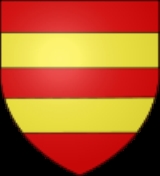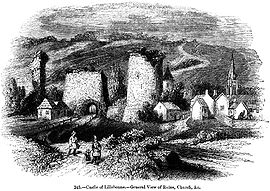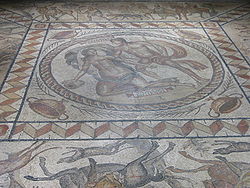
Lillebonne
Encyclopedia
Lillebonne is a commune
in the Seine-Maritime
department in the Haute-Normandie
region in northern France
. It lies 3.5 miles (5.6 km) miles north of the Seine
and 24 miles (39 km) east of Le Havre
by railway.
, Juliobona, was the capital of the Caletes, or inhabitants of the Pays de Caux
, in the time of Julius Caesar
, by whom it was destroyed. It was afterwards rebuilt by Augustus
, and before it was again ruined by the barbarian
invasions it had become an important centre whence Roman roads branched out in all directions. It was an administrative, military and commercial city located close to the Seine. This made it a great transportation route between Brittany (current England) and the remainder of the Roman Empire
. It was also a crossroads of communication in order to bring Roman ways to Harfleur
, Étretat
, Dieppe
, Évreux
and Rouen
.
The remains of Roman bath
s and of a theater
capable of holding 3,000 persons have been brought to light. Many Roman and Gallic
relics, notably a bronze
statue
of a woman and two fine mosaic
s, have been found and transported to the museum at Rouen
. In the Middle Ages
the fortifications of the town were constructed out of materials supplied by the theater. The town recovered some of its old importance under William the Conqueror.
s at the junction of the D982, D29 and the D81 roads.,
 The church of Notre Dame, partly modern, preserves a Gothic
The church of Notre Dame, partly modern, preserves a Gothic
portal of the 16th century and a graceful tower of the same period. The park contains a fine cylindrical donjon and other remains of a castle
founded by William the Conqueror and rebuilt in the 13th century.
 The Gallo-Roman amphitheater of Lillebonne was built in the first century and was altered in the second century so that it could be used as both an amphitheater and a theater. Part of its remains are still visible today from Félix Faur Square, and the foundations of some of its remnants (the wings and backdrop) remain under the square.
The Gallo-Roman amphitheater of Lillebonne was built in the first century and was altered in the second century so that it could be used as both an amphitheater and a theater. Part of its remains are still visible today from Félix Faur Square, and the foundations of some of its remnants (the wings and backdrop) remain under the square.
-spinning and the manufacture of calico
and candle
s.
Petrochemistry is now the main industry in the area, with a part of the nearby Notre-Dame-de-Gravenchon
refining and petrochemical complex extending over the Lillebonne commune.
Communes of France
The commune is the lowest level of administrative division in the French Republic. French communes are roughly equivalent to incorporated municipalities or villages in the United States or Gemeinden in Germany...
in the Seine-Maritime
Seine-Maritime
Seine-Maritime is a French department in the Haute-Normandie region in northern France. It is situated on the northern coast of France, at the mouth of the Seine, and includes the cities of Rouen and Le Havre...
department in the Haute-Normandie
Haute-Normandie
Upper Normandy is one of the 27 regions of France. It was created in 1984 from two départements: Seine-Maritime and Eure, when Normandy was divided into Lower Normandy and Upper Normandy. This division continues to provoke controversy, and some continue to call for reuniting the two regions...
region in northern France
France
The French Republic , The French Republic , The French Republic , (commonly known as France , is a unitary semi-presidential republic in Western Europe with several overseas territories and islands located on other continents and in the Indian, Pacific, and Atlantic oceans. Metropolitan France...
. It lies 3.5 miles (5.6 km) miles north of the Seine
Seine
The Seine is a -long river and an important commercial waterway within the Paris Basin in the north of France. It rises at Saint-Seine near Dijon in northeastern France in the Langres plateau, flowing through Paris and into the English Channel at Le Havre . It is navigable by ocean-going vessels...
and 24 miles (39 km) east of Le Havre
Le Havre
Le Havre is a city in the Seine-Maritime department of the Haute-Normandie region in France. It is situated in north-western France, on the right bank of the mouth of the river Seine on the English Channel. Le Havre is the most populous commune in the Haute-Normandie region, although the total...
by railway.
History
Lillebonne under the RomansRoman Empire
The Roman Empire was the post-Republican period of the ancient Roman civilization, characterised by an autocratic form of government and large territorial holdings in Europe and around the Mediterranean....
, Juliobona, was the capital of the Caletes, or inhabitants of the Pays de Caux
Pays de Caux
The Pays de Caux is an area in Normandy occupying the greater part of the French département of Seine Maritime in Haute-Normandie. It is a chalk plateau to the north of the Seine Estuary and extending to the cliffs on the English Channel coast - its coastline is known as the Côte d'Albâtre...
, in the time of Julius Caesar
Julius Caesar
Gaius Julius Caesar was a Roman general and statesman and a distinguished writer of Latin prose. He played a critical role in the gradual transformation of the Roman Republic into the Roman Empire....
, by whom it was destroyed. It was afterwards rebuilt by Augustus
Augustus
Augustus ;23 September 63 BC – 19 August AD 14) is considered the first emperor of the Roman Empire, which he ruled alone from 27 BC until his death in 14 AD.The dates of his rule are contemporary dates; Augustus lived under two calendars, the Roman Republican until 45 BC, and the Julian...
, and before it was again ruined by the barbarian
Barbarian
Barbarian and savage are terms used to refer to a person who is perceived to be uncivilized. The word is often used either in a general reference to a member of a nation or ethnos, typically a tribal society as seen by an urban civilization either viewed as inferior, or admired as a noble savage...
invasions it had become an important centre whence Roman roads branched out in all directions. It was an administrative, military and commercial city located close to the Seine. This made it a great transportation route between Brittany (current England) and the remainder of the Roman Empire
Roman Empire
The Roman Empire was the post-Republican period of the ancient Roman civilization, characterised by an autocratic form of government and large territorial holdings in Europe and around the Mediterranean....
. It was also a crossroads of communication in order to bring Roman ways to Harfleur
Harfleur
-Population:-Places of interest:* The church of St-Martin, dating from the fourteenth century.* The seventeenth century Hôtel de Ville .* Medieval ramparts * The fifteenth century museums of fishing and of archaeology and history....
, Étretat
Étretat
Étretat is a commune in the Seine-Maritime department in the Haute-Normandie region in northern France. It is a tourist and farming town situated c. 32 km northeast of Le Havre, at the junction of the D940, D11 and D139 roads. It's located on the coast of the Pays de Caux area.-The...
, Dieppe
Dieppe, Seine-Maritime
Dieppe is a commune in the Seine-Maritime department in France. In 1999, the population of the whole Dieppe urban area was 81,419.A port on the English Channel, famous for its scallops, and with a regular ferry service from the Gare Maritime to Newhaven in England, Dieppe also has a popular pebbled...
, Évreux
Évreux
Évreux is a commune in the Eure department, of which it is the capital, in Haute Normandie in northern France.-History:In late Antiquity, the town, attested in the fourth century CE, was named Mediolanum Aulercorum, "the central town of the Aulerci", the Gallic tribe then inhabiting the area...
and Rouen
Rouen
Rouen , in northern France on the River Seine, is the capital of the Haute-Normandie region and the historic capital city of Normandy. Once one of the largest and most prosperous cities of medieval Europe , it was the seat of the Exchequer of Normandy in the Middle Ages...
.
The remains of Roman bath
Thermae
In ancient Rome, thermae and balnea were facilities for bathing...
s and of a theater
Roman theatre (structure)
The characteristics of Roman to those of the earlier Greek theatres due in large part to its influence on the Roman triumvir Gnaeus Pompeius Magnus. Much of the architectural influence on the Romans came from the Greeks, and theatre structural design was no different from other buildings...
capable of holding 3,000 persons have been brought to light. Many Roman and Gallic
Gaul
Gaul was a region of Western Europe during the Iron Age and Roman era, encompassing present day France, Luxembourg and Belgium, most of Switzerland, the western part of Northern Italy, as well as the parts of the Netherlands and Germany on the left bank of the Rhine. The Gauls were the speakers of...
relics, notably a bronze
Bronze
Bronze is a metal alloy consisting primarily of copper, usually with tin as the main additive. It is hard and brittle, and it was particularly significant in antiquity, so much so that the Bronze Age was named after the metal...
statue
Statue
A statue is a sculpture in the round representing a person or persons, an animal, an idea or an event, normally full-length, as opposed to a bust, and at least close to life-size, or larger...
of a woman and two fine mosaic
Mosaic
Mosaic is the art of creating images with an assemblage of small pieces of colored glass, stone, or other materials. It may be a technique of decorative art, an aspect of interior decoration, or of cultural and spiritual significance as in a cathedral...
s, have been found and transported to the museum at Rouen
Rouen
Rouen , in northern France on the River Seine, is the capital of the Haute-Normandie region and the historic capital city of Normandy. Once one of the largest and most prosperous cities of medieval Europe , it was the seat of the Exchequer of Normandy in the Middle Ages...
. In the Middle Ages
Middle Ages
The Middle Ages is a periodization of European history from the 5th century to the 15th century. The Middle Ages follows the fall of the Western Roman Empire in 476 and precedes the Early Modern Era. It is the middle period of a three-period division of Western history: Classic, Medieval and Modern...
the fortifications of the town were constructed out of materials supplied by the theater. The town recovered some of its old importance under William the Conqueror.
Geography
Lillebonne lies in the valley of the Bolbec River at the foot of wooded hillHill
A hill is a landform that extends above the surrounding terrain. Hills often have a distinct summit, although in areas with scarp/dip topography a hill may refer to a particular section of flat terrain without a massive summit A hill is a landform that extends above the surrounding terrain. Hills...
s at the junction of the D982, D29 and the D81 roads.,
Sights

Gothic architecture
Gothic architecture is a style of architecture that flourished during the high and late medieval period. It evolved from Romanesque architecture and was succeeded by Renaissance architecture....
portal of the 16th century and a graceful tower of the same period. The park contains a fine cylindrical donjon and other remains of a castle
Castle
A castle is a type of fortified structure built in Europe and the Middle East during the Middle Ages by European nobility. Scholars debate the scope of the word castle, but usually consider it to be the private fortified residence of a lord or noble...
founded by William the Conqueror and rebuilt in the 13th century.

Economy
The principal industries were cottonCotton
Cotton is a soft, fluffy staple fiber that grows in a boll, or protective capsule, around the seeds of cotton plants of the genus Gossypium. The fiber is almost pure cellulose. The botanical purpose of cotton fiber is to aid in seed dispersal....
-spinning and the manufacture of calico
Calico (fabric)
Calico is a plain-woven textile made from unbleached, and often not fully processed, cotton. It may contain unseparated husk parts, for example. The fabric is less coarse and thick than canvas or denim, but owing to its unfinished and undyed appearance, it is still very cheap. Originally from the...
and candle
Candle
A candle is a solid block or cylinder of wax with an embedded wick, which is lit to provide light, and sometimes heat.Today, most candles are made from paraffin. Candles can also be made from beeswax, soy, other plant waxes, and tallow...
s.
Petrochemistry is now the main industry in the area, with a part of the nearby Notre-Dame-de-Gravenchon
Notre-Dame-de-Gravenchon
Notre-Dame-de-Gravenchon is a commune in the Seine-Maritime department in the Haute-Normandie region in northern France.-Geography:A small town with a huge industrial area to the southwest with farming and woodland to the north and east, in the Pays de Caux, situated by the banks of the river...
refining and petrochemical complex extending over the Lillebonne commune.

